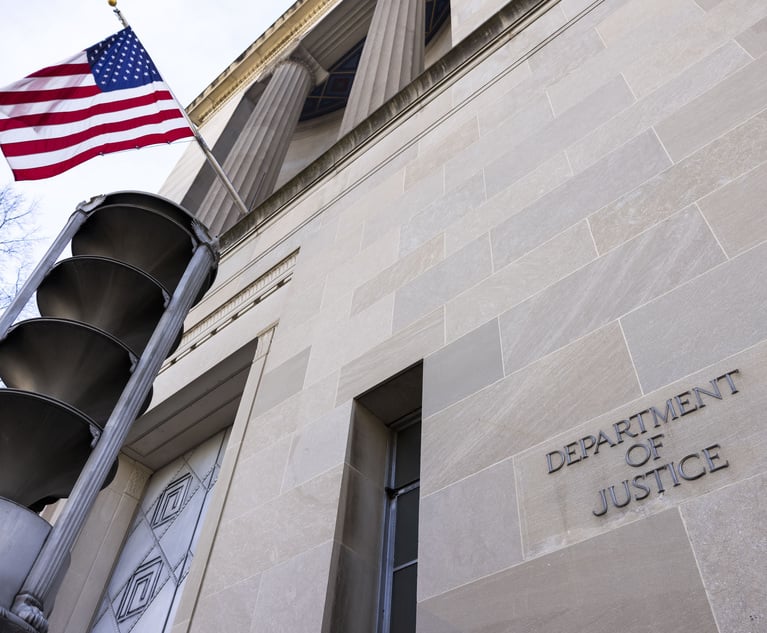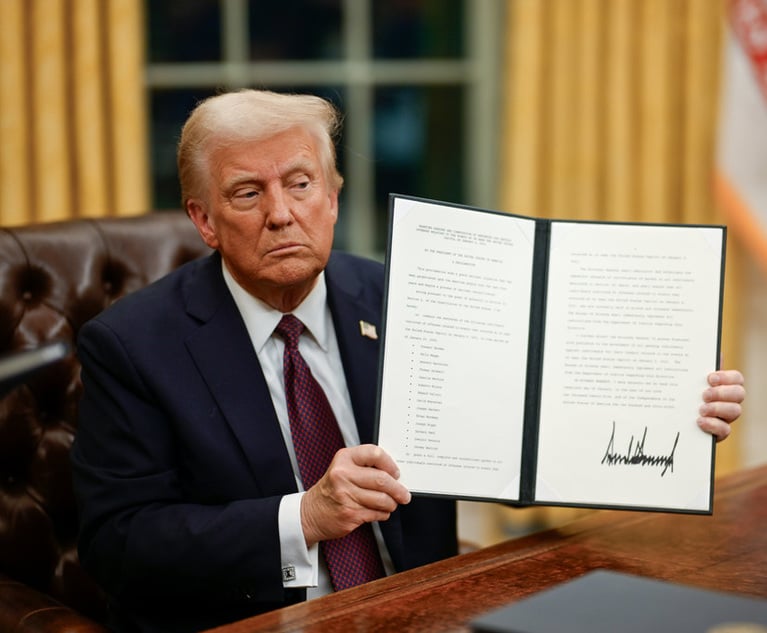Materiality and Admissibility of Evidence in Criminal Securities Fraud Cases
In their White-Collar Crime column, Elkan Abramowitz and Jonathan S. Sack discuss materiality in the context of RMBS trading. Their analysis of recent Second Circuit cases underscores the importance of determining how most effectively to counter government claims of materiality in securities fraud cases.
November 20, 2019 at 12:00 PM
11 minute read
 Elkan Abramowitz and Jonathan Sack
Elkan Abramowitz and Jonathan Sack
Materiality is a critical, often hotly contested, issue in criminal securities fraud prosecutions. In addition to arguing that particular statements were not false, or that particular statements were believed to be true, a defendant commonly argues that the statements at issue were not material to a reasonable investor, and thus do not give rise to a violation of the securities laws.
Materiality—and the related issues of how the government seeks to prove materiality, and how the defense seeks to counter proof of materiality—lies at the heart of a series of important, closely related Second Circuit decisions, beginning with United States v. Litvak, 808 F.3d 160 (2d Cir. 2015) (Litvak I), continuing with United States v. Litvak, 889 F.3d 56 (2d Cir. 2018) (Litvak II), and concluding most recently (in September 2019) with United States v. Gramins, 939 F.3d 429 (2d Cir. 2019). In each of these cases, the defendants—dealers in residential mortgage-backed securities (RMBS)—were accused of defrauding buyers and sellers of RMBS by misrepresenting the prices at which a purchase or sale could be effected, and thereby increasing the profit to the dealers. The decisions in each case turned on whether evidence relating to materiality was properly excluded or admitted at trial.
In this article, after generally discussing materiality in the context of RMBS trading, we analyze the evidence that was excluded and admitted by the district court and explore the link between the substantive issue (whether statements are material) and the evidentiary issue (whether given evidence fairly tends to prove or disprove materiality). This analysis underscores the importance of determining how most effectively to counter government claims of materiality in securities fraud cases.
RMBS and Materiality
RMBS are generally bought and sold in large blocks, worth millions of dollars, by sophisticated financial institutions, such as hedge funds and insurance companies. They are not traded on exchanges like equities, and prices of transactions are not posted contemporaneously. Consequently, market participants lack verifiable information regarding prior trades. Prospective buyers and sellers do business through dealers who seek to find the other side of proposed transactions, or who buy for, or sell from, their own inventory of RMBS. Dealers often have more information about market conditions than buyers and sellers, who commonly look to dealers for "market color" regarding supply and demand. Dealers are compensated primarily through the "spread" or "margin" in a transaction—that is, the difference between the price at which the seller sells, and the buyer buys. In transacting with buyers and sellers, dealers act as principals, not as agents of either side of a trade.
Beginning in 2013, the Department of Justice pursued charges against RMBS dealers who allegedly made false statements in order to widen the spread on transactions and inflate their profits—including the Litvak and Gramins prosecutions noted above, and another prosecution, United States v. Demos, No. 16cr220 (AWT) (D. Conn. 2016), which resulted in an acquittal at trial. The materiality issue was presented starkly because the defendants conceded that they had made false statements, with the effect of widening spreads and increasing profits, but argued that the false statements were not material—because the buyers and sellers made decisions based on internal models and analysis, not based on statements made by dealers in the heat of price negotiation.
In those cases, the test of materiality was not at issue. The government must prove a "substantial likelihood that a reasonable investor would find the misrepresentation important in making an investment decision." Litvak II, 889 F.3d at 64 (alteration omitted) (quoting United States v. Vilar, 729 F.3d 62, 88 (2d Cir. 2013)). A misrepresentation is important to a reasonable investor "if there is a substantial likelihood that the disclosure of the omitted fact would have been viewed by the reasonable investor as having significantly altered the total mix of information made available." Gramins, 939 F.3d at 445 (quotation marks omitted). At issue was whether the misstatements during price negotiations were material to sophisticated investors.
'Litvak I' and 'Litvak II'
In 2013, Jesse Litvak, an RMBS dealer at Jefferies & Co., was charged with several counts of criminal securities fraud. The government alleged that Litvak misrepresented the prices he had paid or would pay for RMBS, resulting in a larger commission to Jefferies (and, by extension, to Litvak). Litvak acknowledged that he had made false statements to buyers and sellers. The defense argued that sophisticated buyers and sellers of RMBS did not attach real importance to the dealer's report of a counterparty's negotiating position. Rather, buyers and sellers made decisions to buy or sell based almost exclusively on their own complex pricing models.
To support this defense, Litvak sought to call an expert witness with substantial experience in the RMBS market. The expert would have testified that a reasonable RMBS trader would not have cared what Litvak said about RMBS prices because buyers and sellers did not use that information to make decisions; they relied on their own internal analysis. The district court excluded the expert testimony as irrelevant, and Litvak was convicted of securities fraud.
On appeal, the Second Circuit held that the trial court's decision to exclude the expert testimony was an abuse of discretion and required a new trial. The court held that the jury would have benefited from an explanation of the complexity of RMBS trading, which was "particularly true because" the pricing of RMBS is "more complicated"—it "tend[s] to be more subjective, [is] available mainly or only from dealers, and [is] often based on models as opposed to prices from prior transactions." Id. The court noted that, had the expert been allowed to testify, the jury "could reasonably have found that misrepresentations by a dealer as to the price paid for certain RMBS would be immaterial to a counterparty that relies not on a 'market' price or the price at which prior trades took place, but instead on its own sophisticated valuation methods and computer model." Litvak I, 808 F.3d at 183.
On remand, Litvak was tried a second time. The defendant's expert testimony was allowed, but the jury found Litvak guilty of one (out of 10) counts of securities fraud, and the district court sentenced Litvak to the same term of incarceration as after the first trial—two years. The defendant appealed, and the Court of Appeals reversed the conviction again.
In Litvak II, the problem was not the exclusion of proffered defense expert testimony, but the admission of testimony the government offered to help prove materiality. At trial, the district court admitted the testimony of Brian Norris, an RMBS trader, who bought and sold RMBS through Litvak. Norris testified that, when deciding whether to buy RMBS and at what price, he accepted as true Litvak's statements about the price of certain bids, and that it "absolutely" "[w]ould … have mattered to" him had he known that Litvak bought the RMBS at a lower price than he represented to Norris. Litvak, 13cr019, Second Trial Tr. 751:20-25.
Central to the appeal was Norris's additional testimony that he believed Litvak was acting "as an agent" in executing the trades. Id. at 748:11-12, 805:5-15. The defense objected in limine to this testimony, but the district court denied the defendant's objection, holding that "it would be highly improper for the government to argue to the jury that Litvak was an agent of the counterparties," but that the counterparties could "testify[ ] about their perception of the relationship between Litvak and themselves" and, "in the course of such testimony, they [would be allowed to say] colloquially … that they understood Litvak to be their 'agent.'" Dkt. No. 432, at 4.
While the Second Circuit observed that evidence of an alleged victim's subjective state of mind is admissible to prove an objective fact—here, what a reasonable investor would have regarded as important—introduction of such testimony has limits, and the court held that those limits were exceeded in the second Litvak trial. Norris's testimony was unfairly prejudicial because it was objectively false in a critical respect. An RMBS dealer is not an agent of, nor does she owe a fiduciary duty to, the client. In light of that falsity, the Second Circuit held that if a victim's testimony is an "idiosyncratic and unreasonable viewpoint," it is not "probative of the views of a reasonable, objective investor in the RMBS market." Litvak II, 889 F.3d at 69. The government argued that any error had been cured by effective cross-examination and a curative instruction to the jury that Litvak was not an "agent" in these transactions. The Second Circuit disagreed. Because "Norris's testimony about a perceived agency relationship was the only rational reason for the jury to have convicted appellant on that count of securities fraud while acquitting him on all other counts," the Second Circuit held that the district court's mistake in admitting the agency testimony was not harmless.
'Gramins'
In the Gramins case, the government charged three former RMBS traders at Nomura Securities International., including Michael Gramins, with conspiracy and substantive securities and wire fraud. The underlying conduct was similar to that in Litvak, and the key issue at trial was again materiality. The government claimed that Gramins made false statements to one of its witnesses, Joel Wollman, who testified that he had "maintained heightened expectations of truthfulness from his broker-dealer" in RMBS trades, but he did not say that he believed Gramins was acting as his agent or fiduciary. Gramins, 939 F.3d at 440. The jury convicted Gramins on the conspiracy count, failed to reach a verdict on one count of securities fraud and one count of wire fraud, and acquitted Gramins on all remaining counts.
In post-trial motions, Gramins argued initially insufficiency of evidence as to materiality, but after the Second Circuit's decision in Litvak II, Gramins added the argument that, through Norris's testimony, the government had improperly implied that Gramins was acting as an agent. According to the defense, Wollman had implied an agency relationship by testifying that, during RMBS trade negotiations, Gramins was "acting on behalf of another counterparty" by "facilitating a trade between [Wollman] and that other counterparty." Gramins, 15cr155, Dkt. No. 496, at 6 (citing Trial Tr. 2113:19-2114:9, 2181:6-10, 2181:16-21, 2271:4-17). In support of this claim, Gramins noted that in a separate RMBS fraud case (Demos), the government agreed (before trial) not to offer any testimony suggesting that Demos was acting as an agent or fiduciary, and the district court prohibited the government from using terms that implied an agency relationship, such as "broker" or "commissions," see Demos, No. 16cr220, Dkt. No. 258, at 1, 4—and in that case, the defendant was acquitted. In Gramins, the district court, relying on Litvak II, granted Gramins's motion for a new trial in light of Wollman's testimony that had, in the court's view, incorrectly implied that a dealer was acting as an agent.
The government appealed, and the Second Circuit reversed the district court and reinstated Gramins's conviction. In the Second Circuit's view, the testimony at issue did not cross the line that was drawn in Litvak II. The court found persuasive that at Gramins's trial, Wollman described Gramins as a "broker" and said that he was "brokering" trades; he did not say that was an "agent." Wollman did not express an "erroneous or idiosyncratic" view of his relationship with Gramins, and his testimony could be regarded as probative of a reasonable investor's view of the materiality of the statements. The court held that Wollman's testimony was relevant, not unduly prejudicial, and not likely to mislead the jury.
Conclusion
Materiality is a fact-intensive and difficult issue in many criminal securities fraud cases. In a series of RMBS fraud prosecutions, the Second Circuit has given guidance to prosecutors and defense counsel for thinking through what evidence may be introduced in support of either side's materiality argument. Defendants may offer competent expert testimony; and the government may present the testimony of victims so long as the victim's understanding of legal duties is not objectively mistaken and so central to the case as to be unfairly prejudicial. The Second Circuit's RMBS fraud decisions provide a framework for future litigation over materiality and admissibility of evidence at trial.
Elkan Abramowitz and Jonathan Sack are members of Morvillo Abramowitz Grand Iason & Anello. Mr. Abramowitz is a former chief of the criminal division in the U.S. Attorney's Office for the Southern District of New York. Mr. Sack is a former chief of the criminal division in the U.S. Attorney's Office for the Eastern District of New York. Joshua Bussen, an associate of the firm, contributed to this article.
This content has been archived. It is available through our partners, LexisNexis® and Bloomberg Law.
To view this content, please continue to their sites.
Not a Lexis Subscriber?
Subscribe Now
Not a Bloomberg Law Subscriber?
Subscribe Now
NOT FOR REPRINT
© 2025 ALM Global, LLC, All Rights Reserved. Request academic re-use from www.copyright.com. All other uses, submit a request to [email protected]. For more information visit Asset & Logo Licensing.
You Might Like
View All
'A Shock to the System’: Some Government Attorneys Are Forced Out, While Others Weigh Job Options
7 minute read
'Serious Legal Errors'?: Rival League May Appeal Following Dismissal of Soccer Antitrust Case
6 minute read
How Some Elite Law Firms Are Growing Equity Partner Ranks Faster Than Others
4 minute read
Trending Stories
- 1ACC CLO Survey Waves Warning Flags for Boards
- 2States Accuse Trump of Thwarting Court's Funding Restoration Order
- 3Microsoft Becomes Latest Tech Company to Face Claims of Stealing Marketing Commissions From Influencers
- 4Coral Gables Attorney Busted for Stalking Lawyer
- 5Trump's DOJ Delays Releasing Jan. 6 FBI Agents List Under Consent Order
Who Got The Work
J. Brugh Lower of Gibbons has entered an appearance for industrial equipment supplier Devco Corporation in a pending trademark infringement lawsuit. The suit, accusing the defendant of selling knock-off Graco products, was filed Dec. 18 in New Jersey District Court by Rivkin Radler on behalf of Graco Inc. and Graco Minnesota. The case, assigned to U.S. District Judge Zahid N. Quraishi, is 3:24-cv-11294, Graco Inc. et al v. Devco Corporation.
Who Got The Work
Rebecca Maller-Stein and Kent A. Yalowitz of Arnold & Porter Kaye Scholer have entered their appearances for Hanaco Venture Capital and its executives, Lior Prosor and David Frankel, in a pending securities lawsuit. The action, filed on Dec. 24 in New York Southern District Court by Zell, Aron & Co. on behalf of Goldeneye Advisors, accuses the defendants of negligently and fraudulently managing the plaintiff's $1 million investment. The case, assigned to U.S. District Judge Vernon S. Broderick, is 1:24-cv-09918, Goldeneye Advisors, LLC v. Hanaco Venture Capital, Ltd. et al.
Who Got The Work
Attorneys from A&O Shearman has stepped in as defense counsel for Toronto-Dominion Bank and other defendants in a pending securities class action. The suit, filed Dec. 11 in New York Southern District Court by Bleichmar Fonti & Auld, accuses the defendants of concealing the bank's 'pervasive' deficiencies in regards to its compliance with the Bank Secrecy Act and the quality of its anti-money laundering controls. The case, assigned to U.S. District Judge Arun Subramanian, is 1:24-cv-09445, Gonzalez v. The Toronto-Dominion Bank et al.
Who Got The Work
Crown Castle International, a Pennsylvania company providing shared communications infrastructure, has turned to Luke D. Wolf of Gordon Rees Scully Mansukhani to fend off a pending breach-of-contract lawsuit. The court action, filed Nov. 25 in Michigan Eastern District Court by Hooper Hathaway PC on behalf of The Town Residences LLC, accuses Crown Castle of failing to transfer approximately $30,000 in utility payments from T-Mobile in breach of a roof-top lease and assignment agreement. The case, assigned to U.S. District Judge Susan K. Declercq, is 2:24-cv-13131, The Town Residences LLC v. T-Mobile US, Inc. et al.
Who Got The Work
Wilfred P. Coronato and Daniel M. Schwartz of McCarter & English have stepped in as defense counsel to Electrolux Home Products Inc. in a pending product liability lawsuit. The court action, filed Nov. 26 in New York Eastern District Court by Poulos Lopiccolo PC and Nagel Rice LLP on behalf of David Stern, alleges that the defendant's refrigerators’ drawers and shelving repeatedly break and fall apart within months after purchase. The case, assigned to U.S. District Judge Joan M. Azrack, is 2:24-cv-08204, Stern v. Electrolux Home Products, Inc.
Featured Firms
Law Offices of Gary Martin Hays & Associates, P.C.
(470) 294-1674
Law Offices of Mark E. Salomone
(857) 444-6468
Smith & Hassler
(713) 739-1250






